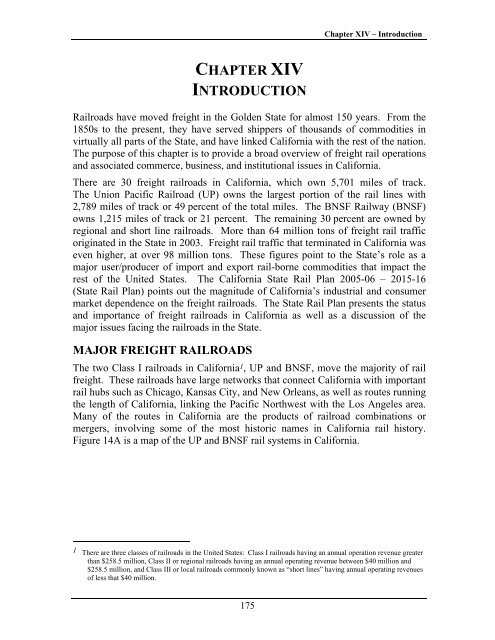California State Rail Plan 2005-06 to 2015-16
California State Rail Plan 2005-06 to 2015-16
California State Rail Plan 2005-06 to 2015-16
You also want an ePaper? Increase the reach of your titles
YUMPU automatically turns print PDFs into web optimized ePapers that Google loves.
Chapter XIV – Introduction<br />
CHAPTER XIV<br />
INTRODUCTION<br />
<strong>Rail</strong>roads have moved freight in the Golden <strong>State</strong> for almost 150 years. From the<br />
1850s <strong>to</strong> the present, they have served shippers of thousands of commodities in<br />
virtually all parts of the <strong>State</strong>, and have linked <strong>California</strong> with the rest of the nation.<br />
The purpose of this chapter is <strong>to</strong> provide a broad overview of freight rail operations<br />
and associated commerce, business, and institutional issues in <strong>California</strong>.<br />
There are 30 freight railroads in <strong>California</strong>, which own 5,701 miles of track.<br />
The Union Pacific <strong>Rail</strong>road (UP) owns the largest portion of the rail lines with<br />
2,789 miles of track or 49 percent of the <strong>to</strong>tal miles. The BNSF <strong>Rail</strong>way (BNSF)<br />
owns 1,215 miles of track or 21 percent. The remaining 30 percent are owned by<br />
regional and short line railroads. More than 64 million <strong>to</strong>ns of freight rail traffic<br />
originated in the <strong>State</strong> in 2003. Freight rail traffic that terminated in <strong>California</strong> was<br />
even higher, at over 98 million <strong>to</strong>ns. These figures point <strong>to</strong> the <strong>State</strong>’s role as a<br />
major user/producer of import and export rail-borne commodities that impact the<br />
rest of the United <strong>State</strong>s. The <strong>California</strong> <strong>State</strong> <strong>Rail</strong> <strong>Plan</strong> <strong>2005</strong>-<strong>06</strong> – <strong>2015</strong>-<strong>16</strong><br />
(<strong>State</strong> <strong>Rail</strong> <strong>Plan</strong>) points out the magnitude of <strong>California</strong>’s industrial and consumer<br />
market dependence on the freight railroads. The <strong>State</strong> <strong>Rail</strong> <strong>Plan</strong> presents the status<br />
and importance of freight railroads in <strong>California</strong> as well as a discussion of the<br />
major issues facing the railroads in the <strong>State</strong>.<br />
MAJOR FREIGHT RAILROADS<br />
The two Class I railroads in <strong>California</strong> 1 , UP and BNSF, move the majority of rail<br />
freight. These railroads have large networks that connect <strong>California</strong> with important<br />
rail hubs such as Chicago, Kansas City, and New Orleans, as well as routes running<br />
the length of <strong>California</strong>, linking the Pacific Northwest with the Los Angeles area.<br />
Many of the routes in <strong>California</strong> are the products of railroad combinations or<br />
mergers, involving some of the most his<strong>to</strong>ric names in <strong>California</strong> rail his<strong>to</strong>ry.<br />
Figure 14A is a map of the UP and BNSF rail systems in <strong>California</strong>.<br />
1 There are three classes of railroads in the United <strong>State</strong>s: Class I railroads having an annual operation revenue greater<br />
than $258.5 million, Class II or regional railroads having an annual operating revenue between $40 million and<br />
$258.5 million, and Class III or local railroads commonly known as “short lines” having annual operating revenues<br />
of less that $40 million.<br />
175













